Seat Mii 2014 Owner's manual
Manufacturer: SEAT, Model Year: 2014, Model line: Mii, Model: Seat Mii 2014Pages: 219, PDF Size: 4.19 MB
Page 191 of 219
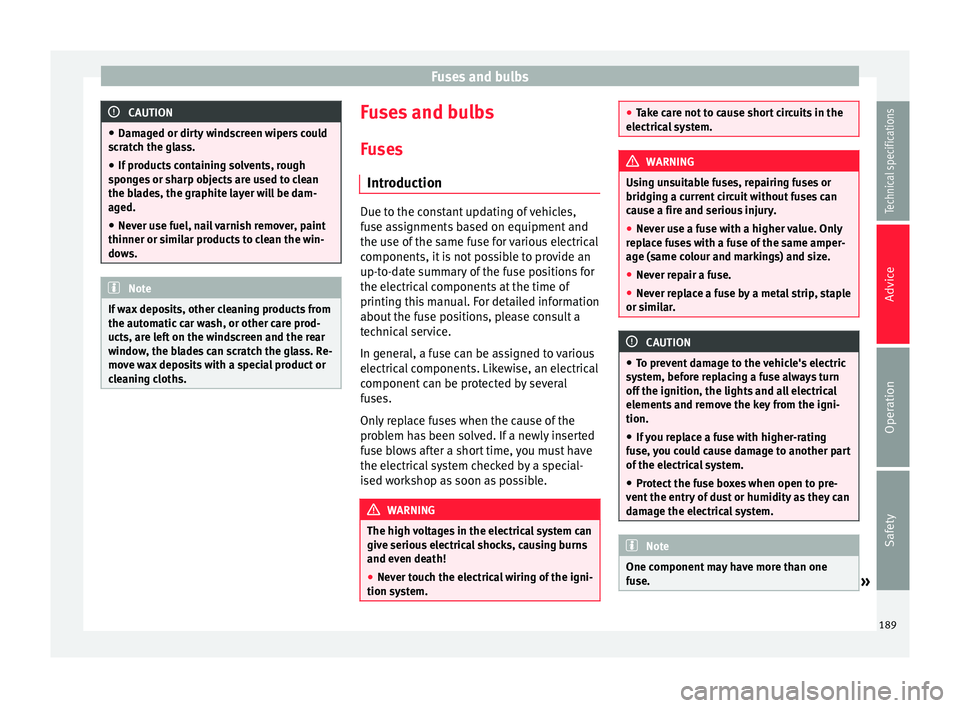
Fuses and bulbs
CAUTION
● Damaged or dirty windscreen wipers could
scratch the glass.
● If products containing solvents, rough
sponges or sharp objects are used to clean
the blades, the graphite layer will be dam-
aged.
● Never use fuel, nail varnish remover, paint
thinner or similar products to clean the win-
dows. Note
If wax deposits, other cleaning products from
the automatic car wash, or other care prod-
ucts, are left on the windscreen and the rear
window, the blades can scratch the glass. Re-
move wax deposits with a special product or
cleaning cloths. Fuses and bulbs
Fuses Introduction Due to the constant updating of vehicles,
fuse assignments based on equipment and
the use of the same fuse for various electrical
components, it is not possible to provide an
up-to-date summary of the fuse positions for
the electrical components at the time of
printing this manual. For detailed information
about the fuse positions, please consult a
technical service.
In general, a fuse can be assigned to various
electrical components. Likewise, an electrical
component can be protected by several
fuses.
Only replace fuses when the cause of the
problem has been solved. If a newly inserted
fuse blows after a short time, you must have
the electrical system checked by a special-
ised workshop as soon as possible.
WARNING
The high voltages in the electrical system can
give serious electrical shocks, causing burns
and even death!
● Never touch the electrical wiring of the igni-
tion system. ●
Take care not to cause short circuits in the
electrical system. WARNING
Using unsuitable fuses, repairing fuses or
bridging a current circuit without fuses can
cause a fire and serious injury.
● Never use a fuse with a higher value. Only
replace fuses with a fuse of the same amper-
age (same colour and markings) and size.
● Never repair a fuse.
● Never replace a fuse by a metal strip, staple
or similar. CAUTION
● To prevent damage to the vehicle's electric
system, before replacing a fuse always turn
off the ignition, the lights and all electrical
elements and remove the key from the igni-
tion.
● If you replace a fuse with higher-rating
fuse, you could cause damage to another part
of the electrical system.
● Protect the fuse boxes when open to pre-
vent the entry of dust or humidity as they can
damage the electrical system. Note
One component may have more than one
fuse. » 189Technical specifications
Advice
Operation
Safety
Page 192 of 219
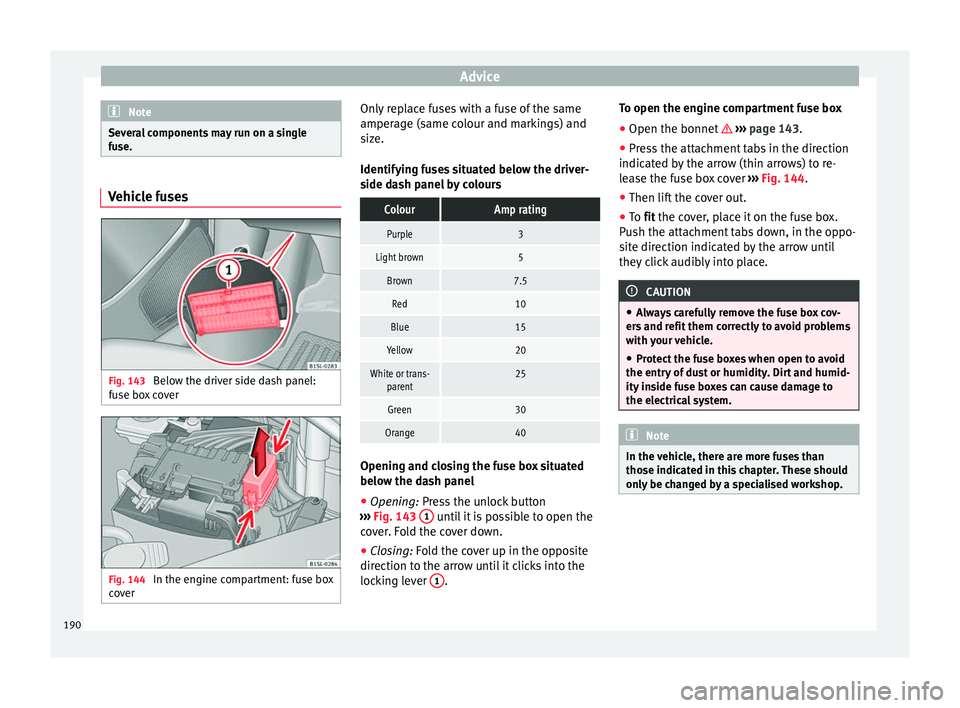
Advice
Note
Several components may run on a single
fuse. Vehicle fuses
Fig. 143
Below the driver side dash panel:
fuse box cover Fig. 144
In the engine compartment: fuse box
cover Only replace fuses with a fuse of the same
amperage (same colour and markings) and
size.
Identifying fuses situated below the driver-
side dash panel by coloursColourAmp rating
Purple3
Light brown5
Brown7.5
Red10
Blue15
Yellow20
White or trans-
parent25
Green30
Orange40 Opening and closing the fuse box situated
below the dash panel
●
Opening: Press the unlock button
› ›
› Fig. 143 1 until it is possible to open the
cover. Fold the cover down.
● Closing: Fold the cover up in the opposite
dir ection t
o the arrow until it clicks into the
locking lever 1 .To open the engine compartment fuse box
●
Open the bonnet ››› page 143.
● Press the attachment tabs in the direction
indicated by the arrow (thin arrows) to re-
lease the fuse box cover ››› Fig. 144 .
● Then lif t
the cover out.
● To fit the cover, place it on the fuse box.
P
ush the attachment tabs down, in the oppo-
site direction indicated by the arrow until
they click audibly into place. CAUTION
● Always carefully remove the fuse box cov-
ers and refit them correctly to avoid problems
with your vehicle.
● Protect the fuse boxes when open to avoid
the entry of dust or humidity. Dirt and humid-
ity inside fuse boxes can cause damage to
the electrical system. Note
In the vehicle, there are more fuses than
those indicated in this chapter. These should
only be changed by a specialised workshop. 190
Page 193 of 219
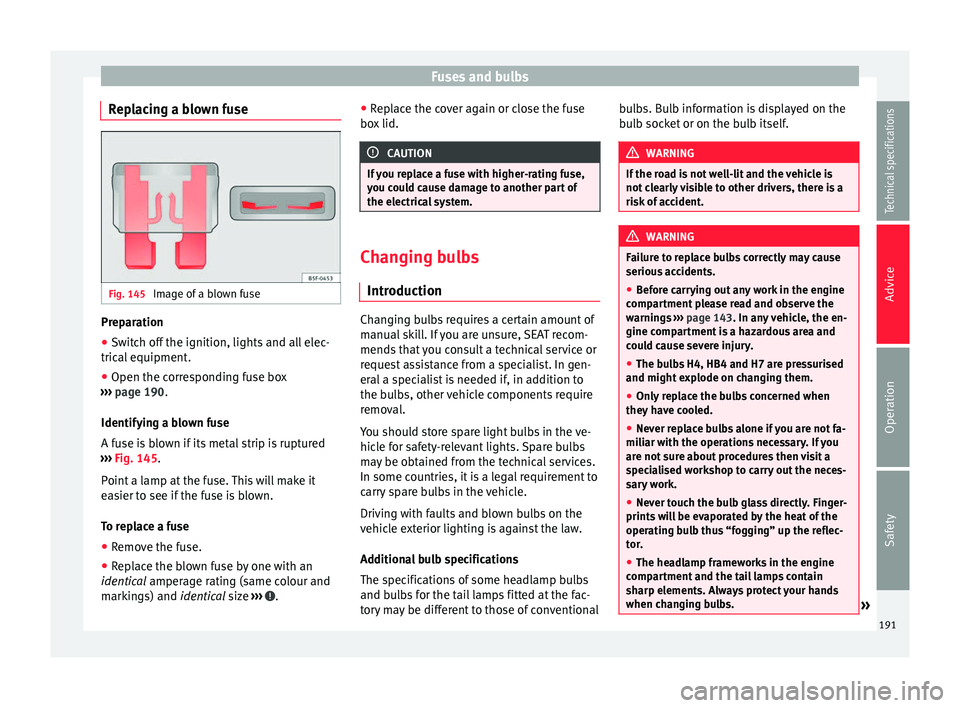
Fuses and bulbs
Replacing a blown fuse Fig. 145
Image of a blown fuse Preparation
● Switch off the ignition, lights and all elec-
trical equipment.
● Open the corresponding fuse box
››› page 190 .
Identif y
ing a blown fuse
A fuse is blown if its metal strip is ruptured
››› Fig. 145.
Point a lamp at the fuse. This will make it
easier to see if the fuse is blown.
To replace a fuse ● Remove the fuse.
● Replace the blown fuse by one with an
identical amperage rating (same colour and
mark
ings) and identical size ››› .●
Replace the cover again or close the fuse
box lid. CAUTION
If you replace a fuse with higher-rating fuse,
you could cause damage to another part of
the electrical system. Changing bulbs
Introduction Changing bulbs requires a certain amount of
manual skill. If you are unsure, SEAT recom-
mends that you consult a technical service or
request assistance from a specialist. In gen-
eral a specialist is needed if, in addition to
the bulbs, other vehicle components require
removal.
You should store spare light bulbs in the ve-
hicle for safety-relevant lights. Spare bulbs
may be obtained from the technical services.
In some countries, it is a legal requirement to
carry spare bulbs in the vehicle.
Driving with faults and blown bulbs on the
vehicle exterior lighting is against the law.
Additional bulb specifications
The specifications of some headlamp bulbs
and bulbs for the tail lamps fitted at the fac-
tory may be different to those of conventionalbulbs. Bulb information is displayed on the
bulb socket or on the bulb itself.
WARNING
If the road is not well-lit and the vehicle is
not clearly visible to other drivers, there is a
risk of accident. WARNING
Failure to replace bulbs correctly may cause
serious accidents.
● Before carrying out any work in the engine
compartment please read and observe the
warnings ››› page 143. In any vehicle, the en-
gine c omp
artment is a hazardous area and
could cause severe injury.
● The bulbs H4, HB4 and H7 are pressurised
and might explode on changing them.
● Only replace the bulbs concerned when
they have cooled.
● Never replace bulbs alone if you are not fa-
miliar with the operations necessary. If you
are not sure about procedures then visit a
specialised workshop to carry out the neces-
sary work.
● Never touch the bulb glass directly. Finger-
prints will be evaporated by the heat of the
operating bulb thus “fogging” up the reflec-
tor.
● The headlamp frameworks in the engine
compartment and the tail lamps contain
sharp elements. Always protect your hands
when changing bulbs. » 191
Technical specifications
Advice
Operation
Safety
Page 194 of 219
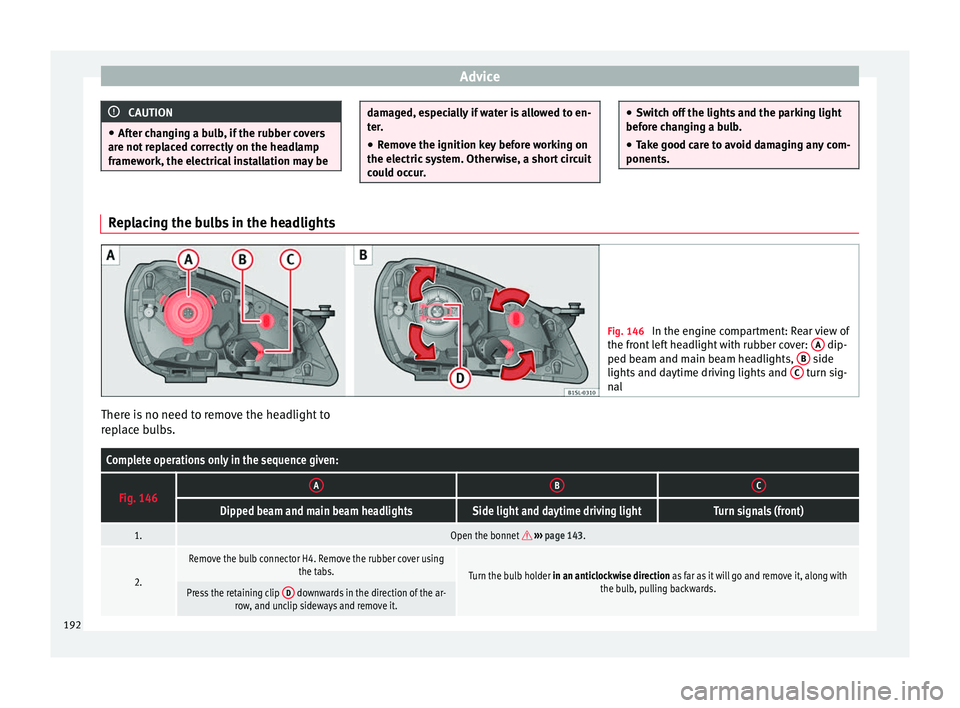
Advice
CAUTION
● After changing a bulb, if the rubber covers
are not replaced correctly on the headlamp
framework, the electrical installation may be damaged, especially if water is allowed to en-
ter.
● Remove the ignition key before working on
the electric system. Otherwise, a short circuit could occur. ●
Switch off the lights and the parking light
before changing a bulb.
● Take good care to avoid damaging any com-
ponents. Replacing the bulbs in the headlights
Fig. 146
In the engine compartment: Rear view of
the front left headlight with rubber cover: A dip-
ped beam and main beam headlights, B side
lights and daytime driving lights and C turn sig-
nal There is no need to remove the headlight to
replace bulbs.Complete operations only in the sequence given:
Fig. 146ABC
Dipped beam and main beam headlightsSide light and daytime driving lightTurn signals (front)
1.Open the bonnet
››› page 143.
2.
Remove the bulb connector H4. Remove the rubber cover using
the tabs.Turn the bulb holder in an anticlockwise direction as far as it will go and remove it, along with the bulb, pulling backwards.Press the retaining clip D downwards in the direction of the ar-
row, and unclip sideways and remove it. 192
Page 195 of 219
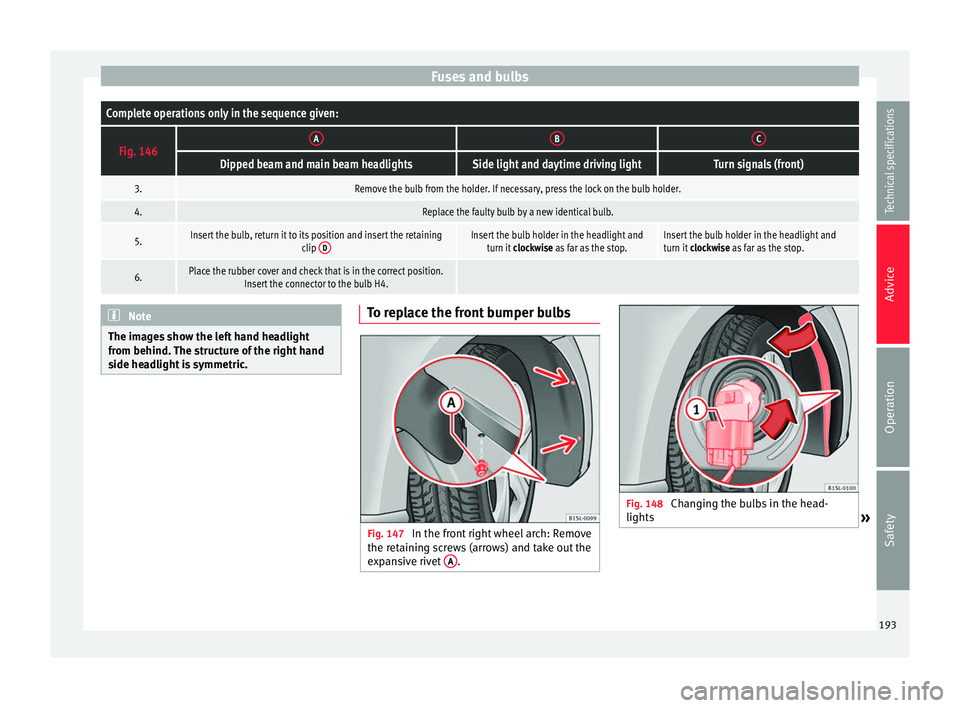
Fuses and bulbsComplete operations only in the sequence given:
Fig. 146ABC
Dipped beam and main beam headlightsSide light and daytime driving lightTurn signals (front)
3.Remove the bulb from the holder. If necessary, press the lock on the bulb holder.
4.Replace the faulty bulb by a new identical bulb.
5.Insert the bulb, return it to its position and insert the retaining
clip DInsert the bulb holder in the headlight and
turn it clockwise as far as the stop.Insert the bulb holder in the headlight and
turn it clockwise as far as the stop.
6.Place the rubber cover and check that is in the correct position.
Insert the connector to the bulb H4. Note
The images show the left hand headlight
from behind. The structure of the right hand
side headlight is symmetric. To replace the front bumper bulbs
Fig. 147
In the front right wheel arch: Remove
the retaining screws (arrows) and take out the
expansive rivet A . Fig. 148
Changing the bulbs in the head-
lights » 193
Technical specifications
Advice
Operation
Safety
Page 196 of 219
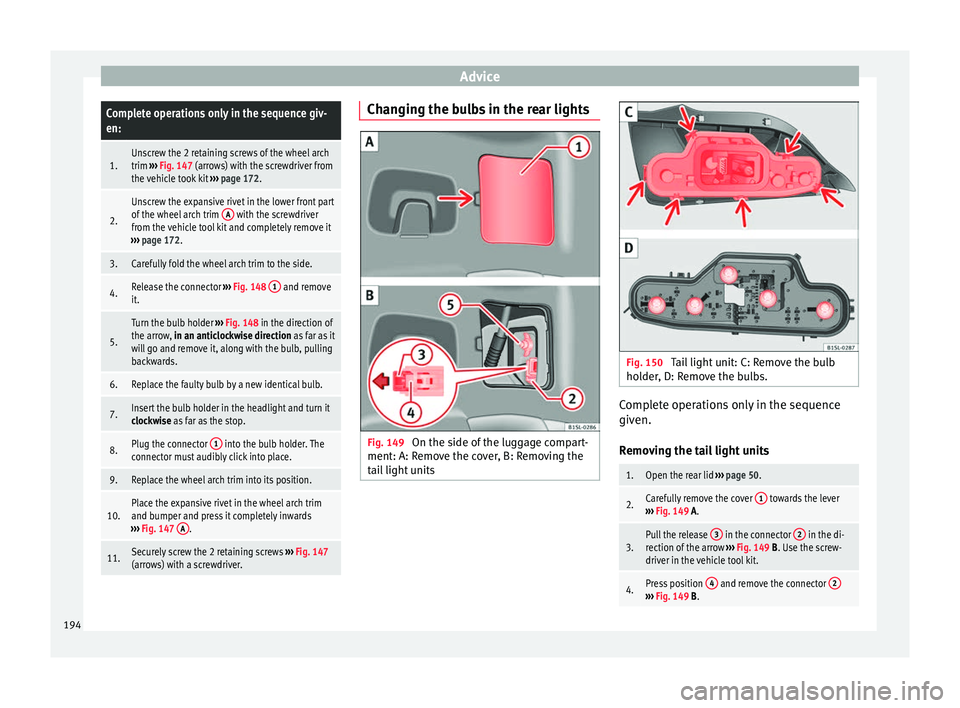
AdviceComplete operations only in the sequence giv-
en:
1.Unscrew the 2 retaining screws of the wheel arch
trim
››› Fig. 147 (arrows) with the screwdriver from
the vehicle took kit ››› page 172.
2.
Unscrew the expansive rivet in the lower front part
of the wheel arch trim A with the screwdriver
from the vehicle tool kit and completely remove it
››› page 172.
3.Carefully fold the wheel arch trim to the side.
4.Release the connector ››› Fig. 148 1 and remove
it.
5.
Turn the bulb holder ››› Fig. 148 in the direction of
the arrow, in an anticlockwise direction as far as it
will go and remove it, along with the bulb, pulling
backwards.
6.Replace the faulty bulb by a new identical bulb.
7.Insert the bulb holder in the headlight and turn it
clockwise as far as the stop.
8.Plug the connector 1 into the bulb holder. The
connector must audibly click into place.
9.Replace the wheel arch trim into its position.
10.Place the expansive rivet in the wheel arch trim
and bumper and press it completely inwards
››› Fig. 147 A
.
11.Securely screw the 2 retaining screws
››› Fig. 147
(arrows) with a screwdriver. Changing the bulbs in the rear lights
Fig. 149
On the side of the luggage compart-
ment: A: Remove the cover, B: Removing the
tail light units Fig. 150
Tail light unit: C: Remove the bulb
holder, D: Remove the bulbs. Complete operations only in the sequence
given.
Removing the tail light units
1.Open the rear lid
››› page 50.
2.Carefully remove the cover 1 towards the lever
››› Fig. 149 A.
3.Pull the release 3 in the connector 2 in the di-
rection of the arrow ››› Fig. 149 B. Use the screw-
driver in the vehicle tool kit.
4.Press position 4 and remove the connector 2›››
Fig. 149 B. 194
Page 197 of 219
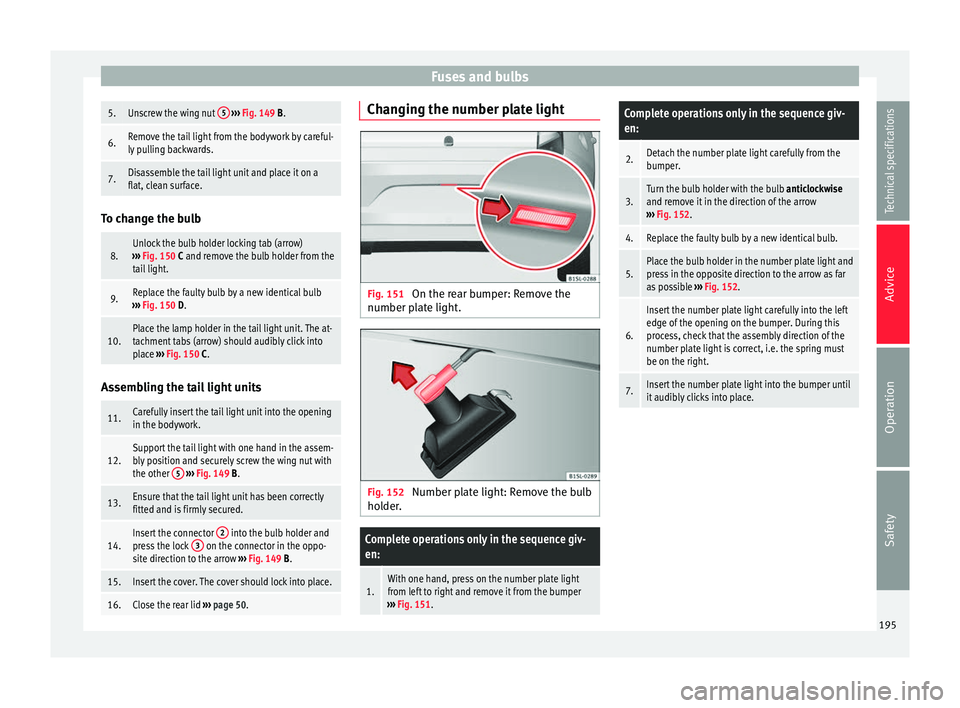
Fuses and bulbs5.Unscrew the wing nut
5
››› Fig. 149 B.
6.Remove the tail light from the bodywork by careful-
ly pulling backwards.
7.Disassemble the tail light unit and place it on a
flat, clean surface. To change the bulb
8.Unlock the bulb holder locking tab (arrow)
››› Fig. 150 C and remove the bulb holder from the
tail light.
9.Replace the faulty bulb by a new identical bulb
››› Fig. 150 D.
10.Place the lamp holder in the tail light unit. The at-
tachment tabs (arrow) should audibly click into
place ››› Fig. 150 C. Assembling the tail light units
11.Carefully insert the tail light unit into the opening
in the bodywork.
12.Support the tail light with one hand in the assem-
bly position and securely screw the wing nut with
the other
5
››› Fig. 149 B.
13.Ensure that the tail light unit has been correctly
fitted and is firmly secured.
14.Insert the connector 2 into the bulb holder and
press the lock 3 on the connector in the oppo-
site direction to the arrow ››› Fig. 149 B.
15.Insert the cover. The cover should lock into place.
16.Close the rear lid ››› page 50. Changing the number plate light
Fig. 151
On the rear bumper: Remove the
number plate light. Fig. 152
Number plate light: Remove the bulb
holder.
Complete operations only in the sequence giv-
en:
1.With one hand, press on the number plate light
from left to right and remove it from the bumper
››› Fig. 151.
Complete operations only in the sequence giv-
en:
2.Detach the number plate light carefully from the
bumper.
3.Turn the bulb holder with the bulb anticlockwise
and remove it in the direction of the arrow
››› Fig. 152.
4.Replace the faulty bulb by a new identical bulb.
5.Place the bulb holder in the number plate light and
press in the opposite direction to the arrow as far
as possible ››› Fig. 152.
6.
Insert the number plate light carefully into the left
edge of the opening on the bumper. During this
process, check that the assembly direction of the
number plate light is correct, i.e. the spring must
be on the right.
7.Insert the number plate light into the bumper until
it audibly clicks into place. 195
Technical specifications
Advice
Operation
Safety
Page 198 of 219
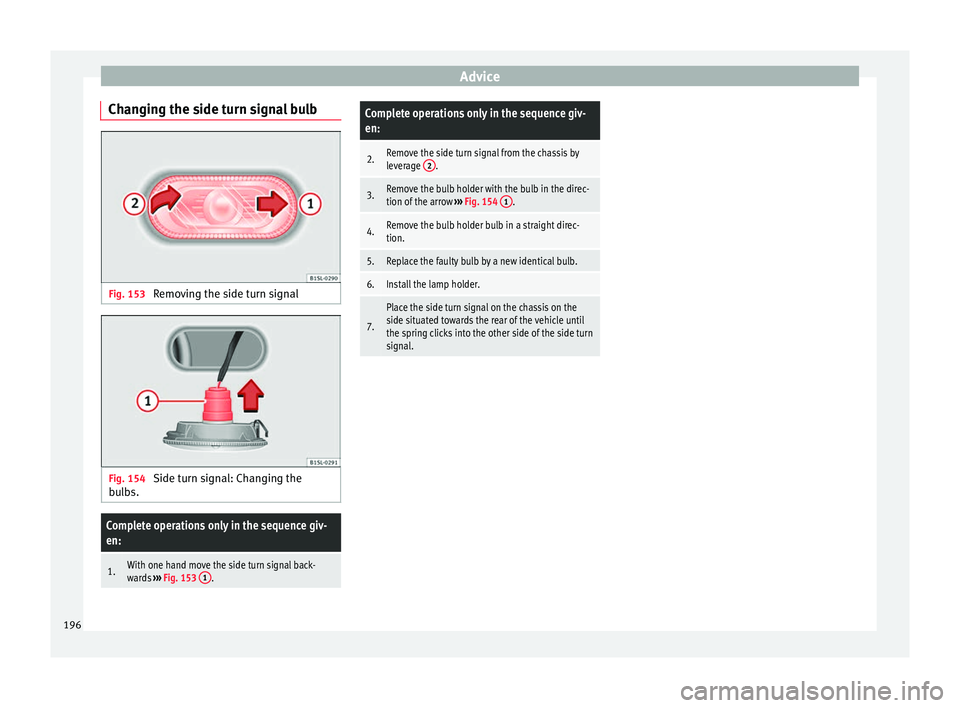
Advice
Changing the side turn signal bulb Fig. 153
Removing the side turn signal Fig. 154
Side turn signal: Changing the
bulbs.Complete operations only in the sequence giv-
en:
1.With one hand move the side turn signal back-
wards ››› Fig. 153 1.
Complete operations only in the sequence giv-
en:
2.Remove the side turn signal from the chassis by
leverage 2.
3.Remove the bulb holder with the bulb in the direc-
tion of the arrow
››› Fig. 154 1.
4.Remove the bulb holder bulb in a straight direc-
tion.
5.Replace the faulty bulb by a new identical bulb.
6.Install the lamp holder.
7.
Place the side turn signal on the chassis on the
side situated towards the rear of the vehicle until
the spring clicks into the other side of the side turn
signal.196
Page 199 of 219

Technical features
Technical specifications
Technical features
Important information Introduction The information in the vehicle documentation
always takes precedence over the informa-
tion in this Instruction Manual.
All technical specifications provided in this
documentation are valid for the standard
model in Spain. The vehicle data card inclu-
ded in the Maintenance Programme or the
vehicle registration documents shows which
engine is installed in the vehicle.
The figures may be different depending
whether additional equipment is fitted, for
different models, for special vehicles and for
other countries.
Abbreviations used in the Technical
Specifications sectionAbbrevi-
ationMeaning
kWKilowatt, engine power measurement.
PSPferdestärke (horsepower), formerly used
to denote engine power.
rpmRevolutions per minute - engine speed.
NmNewton metres, unit of engine torque.
litres per100 kmFuel consumption in litres per 100 km (70
miles).
g/kmCarbon dioxide emissions in grams per km
(mile) travelled.
CO 2Carbon dioxide
CNCetane number, indication of the diesel
combustion power.
RONResearch octane number, indication of the
knock resistance of petrol. Vehicle identification data
Fig. 155
Vehicle data label. Fig. 156
Vehicle identification number. Vehicle identification number
The vehicle identification number (chassis
number) can be read from outside the vehicle
through a viewer in the windscreen
››› Fig. 156 . This viewer is located in the lower
»
197
Technical specifications
Advice
Operation
Safety
Page 200 of 219

Technical specifications
part of the windscreen. The vehicle identifica-
tion number (chassis number) is also stam-
ped on the right water drain channel. The wa-
ter drain channel is located between the sus-
pension tower and the wing. Open the bon-
net to read the vehicle identification number
.
V ehic
le data plate
The vehicle data label ››› Fig. 155 is at the
front
of the spare wheel well. It contains the
following data:
Vehicle identification number (chassis
number).
Vehicle type, engine power, gearbox type.
Engine and gearbox code, paint number,
interior equipment.
Optional extras, PR numbers.
These data are also provided in the Mainte-
nance Programme.
Specific vehicle weight information The instructions in the official vehicle docu-
ments take precedence. All the technical data
provided in this documentation is applicable
to the basic model. The vehicle data label in
the Maintenance Programme or the vehicle
documentation shows which engine is instal-
led in your vehicle.1 2
3
4 The figures may be different depending
whether additional equipment is fitted, for
different models and for special vehicles.
Kerb weight values shown in the following ta-
ble apply to a vehicle with driver (75 kg), liq-
uids including a fuel tank 90% full, in addi-
tion to tools and a spare wheel
››› . The
kerb weight indicated increases with optional
equipment and retrofitting of accessories,
while proportionally reducing carrying ca-
pacity.
The load is equivalent to the following
weights:
● Passengers.
● Total equipment.
● Roof load, included in the carrier. WARNING
Exceeding the maximum authorised weight
and the load on the axles could cause dam-
age to the vehicle, accidents and serious in-
juries.
● The real load on the axles should never ex-
ceed the maximum permitted.
● The load and its distribution in the vehicle
have effects on the vehicle handling and the
braking ability. Always drive at a suitable
speed. CAUTION
Distribute the load as uniformly and as low
down on the vehicle as possible. When trans-
porting heavy objects in the luggage com-
partment, these should be placed as far for-
ward as possible or over the rear axle to have
as little influence on handling as possible. Information on fuel consumption
The consumption and emission values indi-
cated do not refer to one specific vehicle.
They are only to be used to compare the val-
ues of the different vehicle versions. The fuel
consumption and CO
2 emissions of a vehicle
not only depend on the effective use of fuel.
They also depend on your driving style and
other non-technical factors.
Calculation of fuel consumption
Fuel consumption and emission values are
determined according to the current version
of the 715/2007/EC or 80/1268/EEC regula-
tion and are valid for the vehicle kerb weight.
The specifications do not
refer to an individu-
al
vehicle. To measure the fuel consumption,
two measuring cycles are carried out on a
rolling road test bed. The test criteria are as
follows:
198